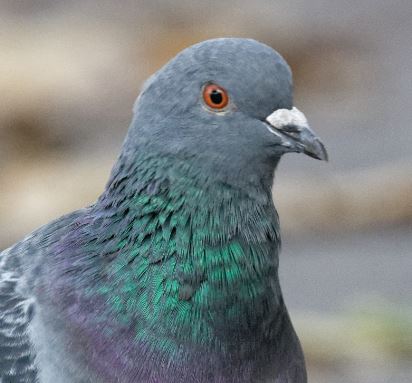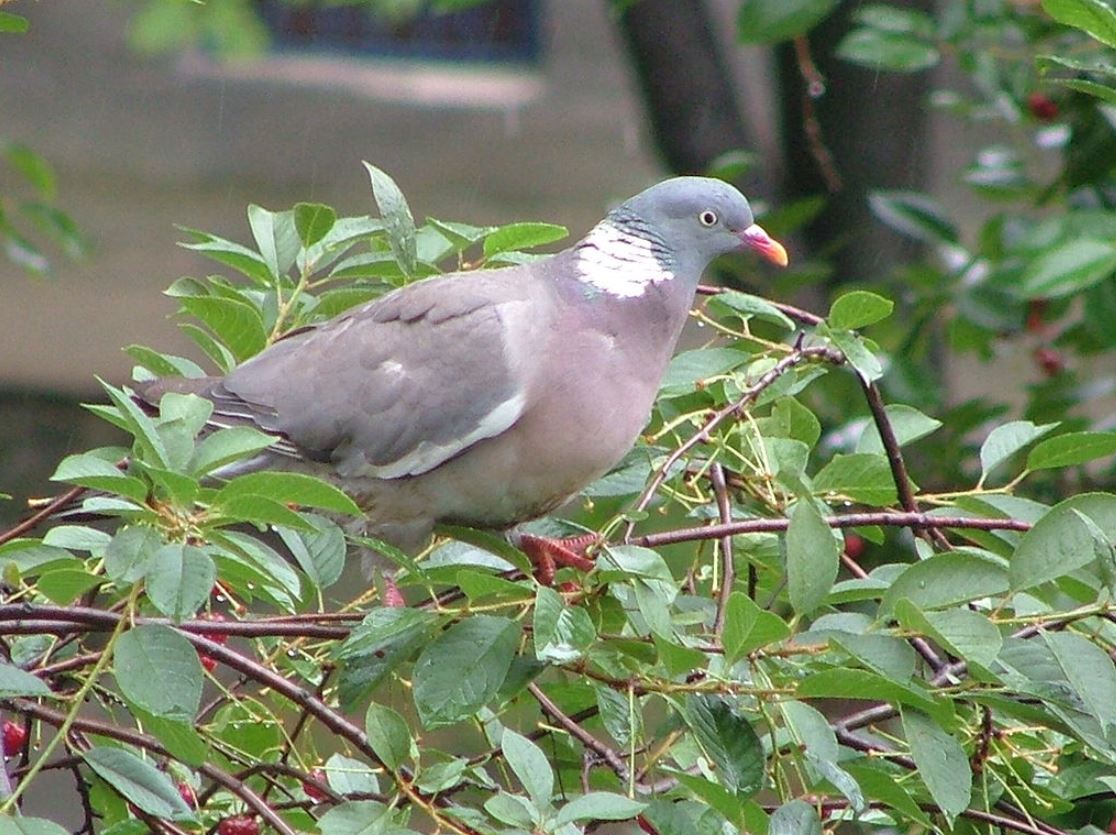The large family Columbidae comprises 351 different species. Pigeons are one of them, along with turtle doves, pigeons and others. In Europe, there are mainly 3 species of pigeons: the rock pigeon, the wood pigeon and the stock pigeon.
The rock pigeon has been domesticated since ancient times and the city pigeons found in urban centres are mostly descendants of these domesticated pigeons.
The wood pigeon can also be called palombe, especially in the south-west of France.
The third species is more discreet: the stock pigeon. Its plumage is more uniform and it lives mainly in forests. But it is also adapting to cities, where it is increasingly found.
The rock pigeon (Columba livia)
Credit : Marie-Lan Taÿ Pamart, CC BY 4.0, via Wikimedia Commons
- Lifespan: 6 years
- Size: 34 cm
- Weight : from 240 to 300 g
Physical description
The rock pigeon can be distinguished by the emerald to violet reflections on its neck. Its orange-red irises are also very distinctive. It is smaller than the wood pigeon. It has two black bands on its wings and a small whitish bump at the base of its beak.
Diet
Rock pigeons are granivores. In tropical areas they will also eat fruit. In cities, they may also eat leftovers such as crumbs.
Habitat and distribution
The rock pigeon is found in almost all parts of the world. In Europe, they are particularly fond of rocky areas, but they are most often seen in cities where their presence can become a problem for certain human activities.
These birds are gregarious, outside the breeding season, and live in groups.
Nesting sites and period
The nest of the rock pigeon is rather crude and consists of a pile of dry branches. In a rural environment, it may nest in small cavities on cliffs. In cities, it will nest in holes in buildings or on ledges.
The breeding season runs from February to October and frequently has 3 clutches. There are usually two eggs in a clutch.
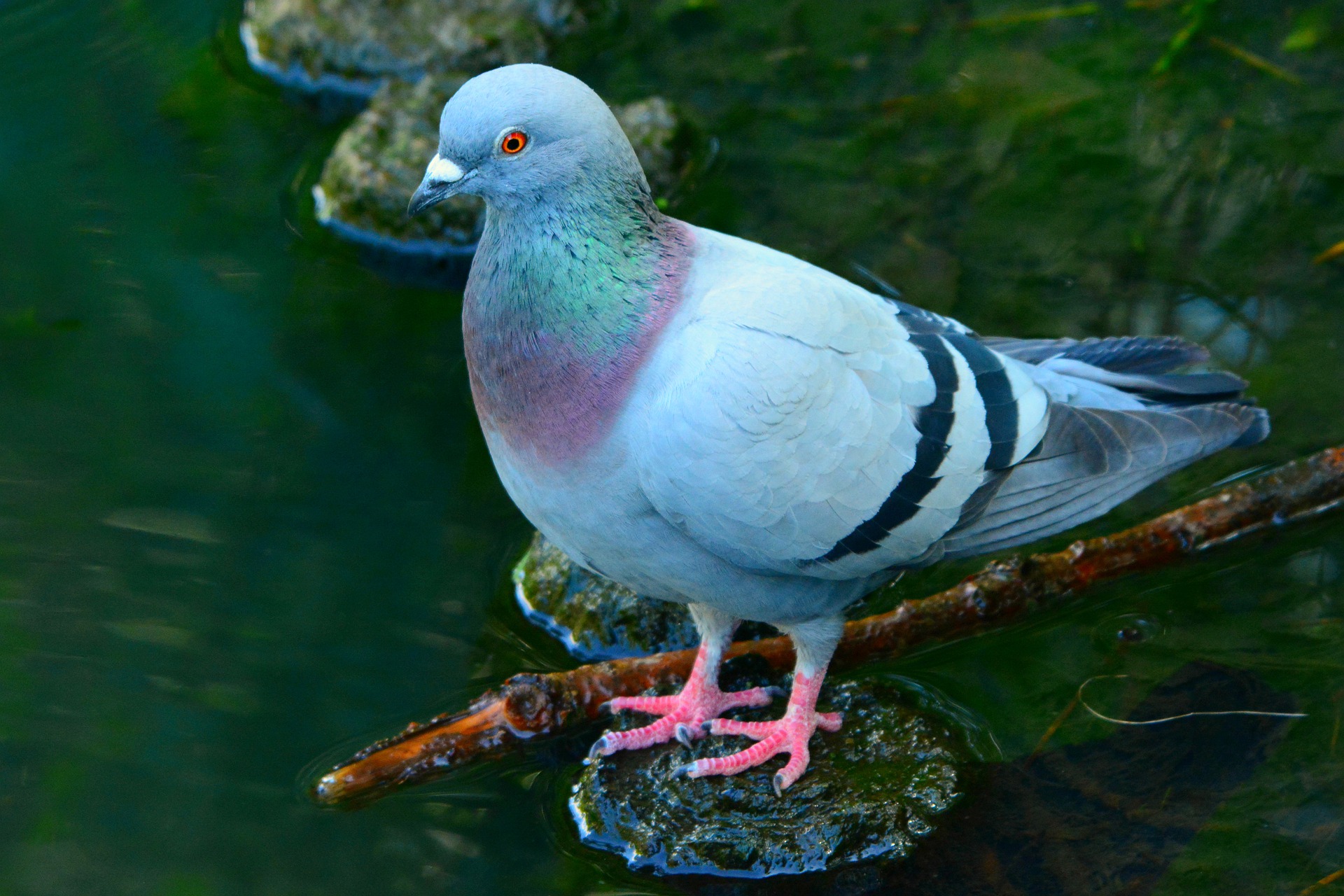
Possible scaring methods
This bird is not sensitive to sound scaring. It has lived in direct proximity to humans for too long and is not sensitive to this repellent method.
If the birds are nesting in the building to be protected, it is necessary to remove the nests and block their access in the first instance. In a second stage, laser scaring will be used to finish making the area inhospitable to them.
In certain cases where the pressure is too great (many nests, more than twenty pigeons installed for several years, etc.), it is better to call in a specialised company to intervene on the site in question.
Wood pigeon (Columba palumbus)
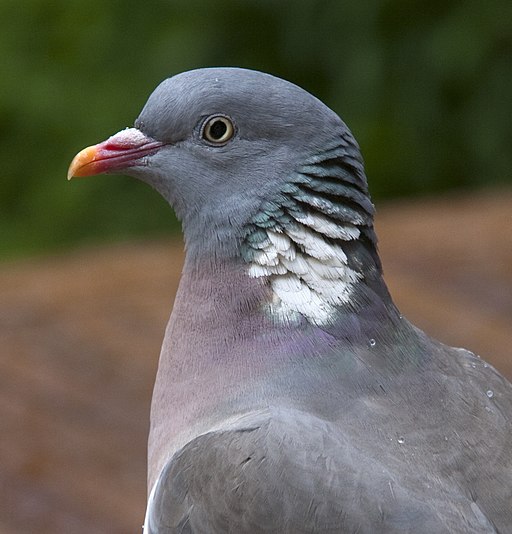
Crédit : Tony Hisgett from Birmingham, UK, CC BY 2.0, via Wikimedia Commons
- Lifespan: 16 years
- Size: 45 cm
- Weight: 450-520 g
Physical description
The wood pigeon can be distinguished by the white patch on each side of its neck and its yellow iris. It is also the only pigeon with white wing bands.
Diet
Wood pigeons are granivores. In tropical regions, they will also eat fruit. The wood pigeon is well known to farmers because it also gets a large part of its food from agricultural land. It can cause considerable damage to sunflower fields, especially at sowing time.
Habitat and migratory behaviour
The wood pigeon lives most frequently in the countryside, in wooded areas. It is sometimes found in cities. Woodpigeons living in the wild in the countryside, away from human habitats, are more shy than their urban cousins.
Wood pigeons found in mainland France are sedentary, as are wood pigeons living in Western Europe. Populations living in regions with harsher winters, in Northern Europe, migrate in October to the Iberian Peninsula.
Migratory wood pigeon colonies spend the autumn in south-western France, where hunting is highly developed. The palombières (hunting sites for migratory wood pigeons, known as palombes) are widespread in the departments where the birds make their stopovers: Lot-et-Garonne, Landes, Gers, etc.
Breeding sites and period
The breeding season runs from February to September depending on the area. Each litter contains 2 eggs and it is possible that there are 2 or even 3 clutches over the period. This species mainly lays eggs in trees. Wood pigeons can also be found in cities. They adapt their methods and may nest on balconies or other suitable perches.
Crédit : Wardrin, CC BY-SA 4.0, via Wikimedia Commons
Possible scaring methods
If the pigeons to be repelled are "wild" and shy, it is possible to scare them away by means of acoustic repellers, sometimes supplemented by visual solutions.
However, wood pigeons living in cities are used to a noisy environment (horns, cars, etc.) and to the proximity of human activities. These pigeons are therefore not very sensitive to noise scaring.
To keep these birds away, physical protection methods such as nets, spikes or repellent gel cups should be used.
Stock dove (Columba oenas)
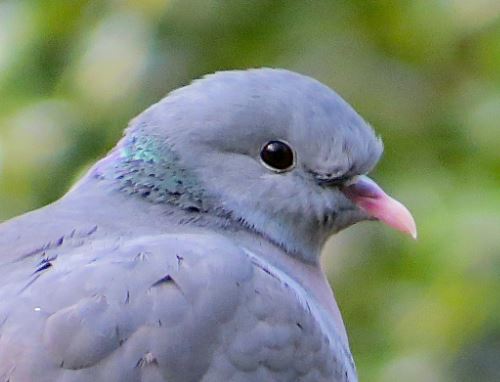
Crédit : Par MPF — Travail personnel, CC BY-SA 4.0
- Lifespan: 13 years
- Size: 34 cm
- Weight : 250 to 340 g
Physical description
Smaller in size than the wood pigeon and the rock pigeon, the pigeon is also distinguished by its more uniform plumage. Its completely black iris also makes it impossible to confuse it with other species.
Diet
Depending on the season, the pigeon's diet consists of seeds, young shoots and what is left over after the harvest in the fields cultivated by man.
Habitat and migratory behaviour
The pigeon lives mainly in forested areas but is also found in city centres, along with wood pigeons and rock pigeons. It is found in Europe, Asia and northern Africa. In some areas it may be migratory (in northern Europe and Asia, but also in Central Asia).
Nesting sites and period
Unlike the other two species described, the pigeon nests in cavities on cliffs or trees. Sometimes they choose to nest in nest boxes as well.
During the breeding season, this species keeps the same partner.
The clutches consist of 2 eggs (this is the norm in the Columbidae family). The breeding season is from April to June depending on the area.
,_Craigleith,_Edinburgh_-_geograph-org-uk_-_1229775.jpg)
Possible scaring methods
Sources :

